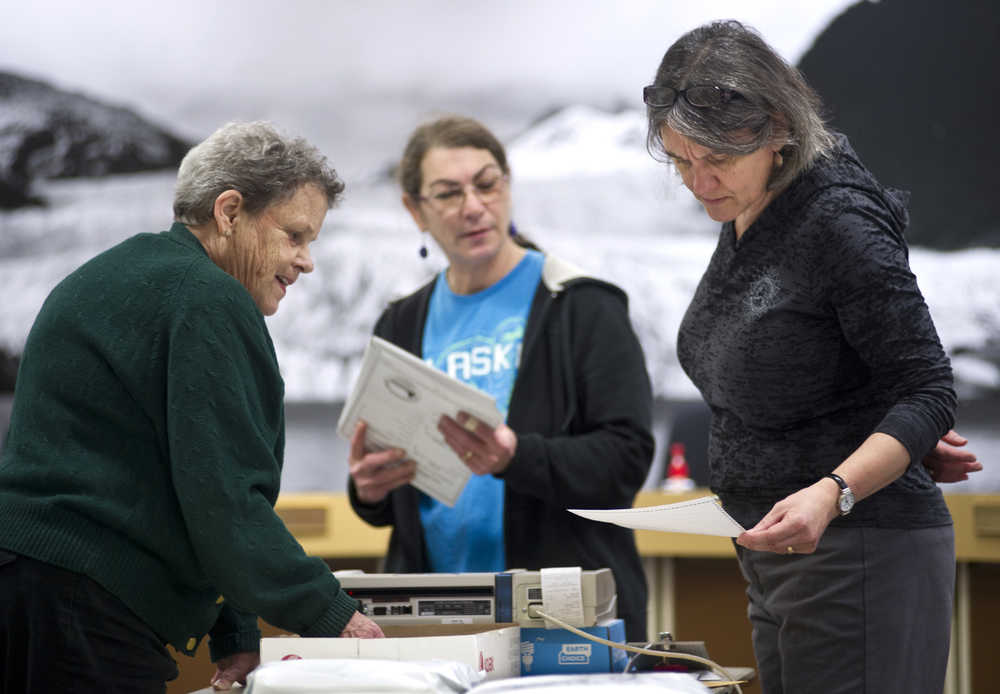Editor’s note: This is the first in a two-part series exploring Juneau’s low voter turnout. Part two will publish Monday, Oct. 12.
When the polls closed Tuesday night for this year’s municipal election, voter turnout was about 18 percent. By the time a small group of volunteers finished counting the absentee and questioned ballots Friday afternoon turnout had increased to 23.5 percent — the second lowest turnout it at least 30 years.
Voter turnout for city elections in Juneau hit what was likely an all-time low just two years ago at 19.1 percent. It’s difficult to know for sure whether this was the lowest turnout in city history because election records from before 1985 are hand written and nearly impossible to read. After climbing briefly to 29 percent in 2014, turnout dropped again this year in keeping with a troubling trend.
Since the late 1980s, though possibly earlier, voter turnout in municipal elections has been getting worse, and nobody seems to know exactly what is causing this problem or how to fix it.
A perplexing problem
Laurie Sica has been serving as the city clerk and elections official since 2000. During her first year overseeing the city’s municipal elections voter turnout was nearly 50 percent, a six-year high at the time. It hasn’t come close to that number since. In fact, since then turnout reached unprecedented lows three times.
This is not to say that Sica is in any way connected to the declining turnout. It had been trending down for more than a decade before she stepped into her current role. But this problem has been on the city’s radar for quite some time.
“People have so much more information now, and they pay less attention to what’s going on,” Sica said, hazarding a guess as to why turnout has decreased. “Maybe they’re just more apathetic.”
Turnout hasn’t worsened every year. There is an ebb and flow, and some years are higher than others. What’s troubling is that the peaks in the data aren’t nearly as high as they used to be and the trenches are getting deeper.
“It’s a little bit of a disturbing trend to me,” said CBJ Assembly member Jesse Kiehl, who like most everybody else has noticed the declining turnout. “Representative government always works best when the most people weigh in.”
Sica said that turnout is usually better in years during which municipal elections overlap with state and presidential elections, and this has been the case often enough that most people, Kiehl included, have made similar observations. The problem is that these elections only overlap every two to four years. Though these years have occasionally coincided with some of the highest voter turnouts during the past 30 years, it hasn’t always been the case.
Ballot bailout
From 2007 to 2008, which was both a state and presidential election year, turnout for the municipal election dropped from 40.4 percent to 26.3 percent. This was likely due to the fact that the municipal election of 2007 included several notable ballot measures, which also tend to increase voter turnout. And 2007’s ballot included propositions to build the Diamond Park Aquatic Center and to remove fluoride city water, both of were highly publicized issues. The ballot in 2008 wasn’t quite as full.
“People turn out for ballot measures and that shows,” said Robert Barr, Juneau’s library director and one of the founding members of Juneau Votes, a grass roots organization with the purpose of increasing voter participation. “When we vote on a question, people come out. But the people who we elect vote on questions like those every week.”
Like Kiehl, Sica and many others, Barr noted the apparent connection tying high turnout in municipal elections to state and presidential elections. But this relationship is generally more difficult to follow, and less correlative, than the relationship between state and presidential elections alone. Typically there is a surge in the polls for state elections during presidential election years, and this makes sense. These elections are held on the same day and share a ballot. Presidential races are often enough to inspire voters who might not otherwise care enough to head to the polls to decide their state representatives.
Juneau’s city elections, however, are held a month earlier on the first Tuesday of October, per the City and Borough of Juneau Charter. Though the big elections help to get people in the voting mood for the smaller city races — a familiar fact for Sica and others — it’s tough to know exactly how they will influence municipal election turnout.
“People just seem more election minded in those years,” Sica said.
• Contact reporter Sam DeGrave at sam.degrave@juneauempire.com or at (907) 523-2279.

